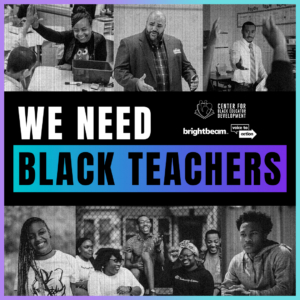#87 – Three Key Factors + Supporting Male Educators of Color
Written by Greg Schermbeck, Founder & Principal
“I believe nothing undermines the number of Black teachers more than the school-based experiences of Black students and teachers”
– Sharif El-Mekki, Founder & Chief Executive Officer, Center for Black Educator Development
–
The data is clear: male educators of color often positively impact students, both male students of color and the general student body. Despite the positive data, male educators of color usually comprise less than 3% of the general teaching population. There are many reasons for this current reality: biased hiring decisions, structural racism, and minimal support for these educators inside school districts – but there is hope.
Our team has been fortunate to partner with innovative organizations nationwide focused on recruiting, retaining, and developing male educators of color. Our experience working in 7+ markets has allowed us to understand the various dynamics that shape an educational landscape and, thus, the pathway to supporting male educators of color: local funding systems, proximity to HBCUs and diverse teacher prep programs, etc. Beyond these dynamics, we’ve also been able to identify three consistent drivers across these markets that have created the most promising progress in a community to support male educators of color:
- Community Foundation + Education Non-Profit
- District Commitment + Data
- Money
Let me share additional context for how our team has seen these key drivers work towards creating a more equitable teaching experience for male educators of color.
- Community Foundation + Education Non-Profit
- The presence of a community foundation and/or education non-profit focused on supporting male educators of color is paramount. Often, these organizations work together; the foundation raises/distributes the money, and the non-profit leads the work. These entities are also well-positioned to lead community conversations, galvanize support from the business community, and have organizational flexibility to stand-up programming focused on such a critical initiative.
- Further, one or both of these groups can serve as subject matter experts and center point in the community to move the work forward.
2. District Commitment + Data
- Often, school districts dominate the market share of teachers in any community. Thus, their recruiting, hiring, and development practices determine the demographic of the teaching population in cities across the country.
- Given the power and size of most school districts, these organizations must be committed to supporting male educators of color and willing to share non-identifiable data to make informed decisions.
- Commitment can take multiple shapes: being present at community meetings, building a staff solely to support male educators of color, and simply naming their intention to do better by male educators of color.
- The data piece is critical:
- Does your district track where teachers are coming from by gender and race?
- Are they making informed recruiting decisions based on this data?
- Does your district track attrition by gender and race?
- Are they building retention and development opportunities based on this data?
- Does your district track where teachers are coming from by gender and race?
- Districts that leverage this data, share it with their community partners, and use it to drive their decisions will continue making real strides to support male educators of color better.
3. Money
- Even the best-intentioned school districts can’t move quickly on launching such initiatives due to local and state-wide funding systems. Funding, and ideally multi-year commitments from local and national funders, will allow emerging initiatives the runway to capture actual results and confirm additional support towards sustainability.
- Working in partnership with the community foundations and/or the non-profit leading the charge, school districts present a powerful force to ask and attract funds to sustain the work.
These three factors are not a silver bullet, nor do they guarantee overnight success as it relates to creating a thriving community of male educators of color. Many other variables should be considered: commitment to anti-racism, teacher pay, demographics of your community, etc. However, system-level change requires movement at all levels to create a more equitable society. These factors in your community will clear a path for male educators of color to thrive.
–
More to do. More to come. ®
Action Steps
- Assess your local community with the three factors mentioned in this post. Are any of these factors present in your community?
- If so, can you connect with them to build an effort to support male educators of color?
- If not, can you create a community to build toward one of these factors?
- Research organizations at the forefront of this work. A small sample to start with:
- Tennessee Educators of Color Alliance
- Center for Black Educator Development
- Jacksonville Public Education Fund
- NewSchools Venture Fund
- Profound Gentlemen
Send me a note or leave a comment. I’d love to hear your reactions to this post, what you’ve seen in your experience, and your thoughts on supporting male educators of color.


Leave a Reply
Want to join the discussion?Feel free to contribute!